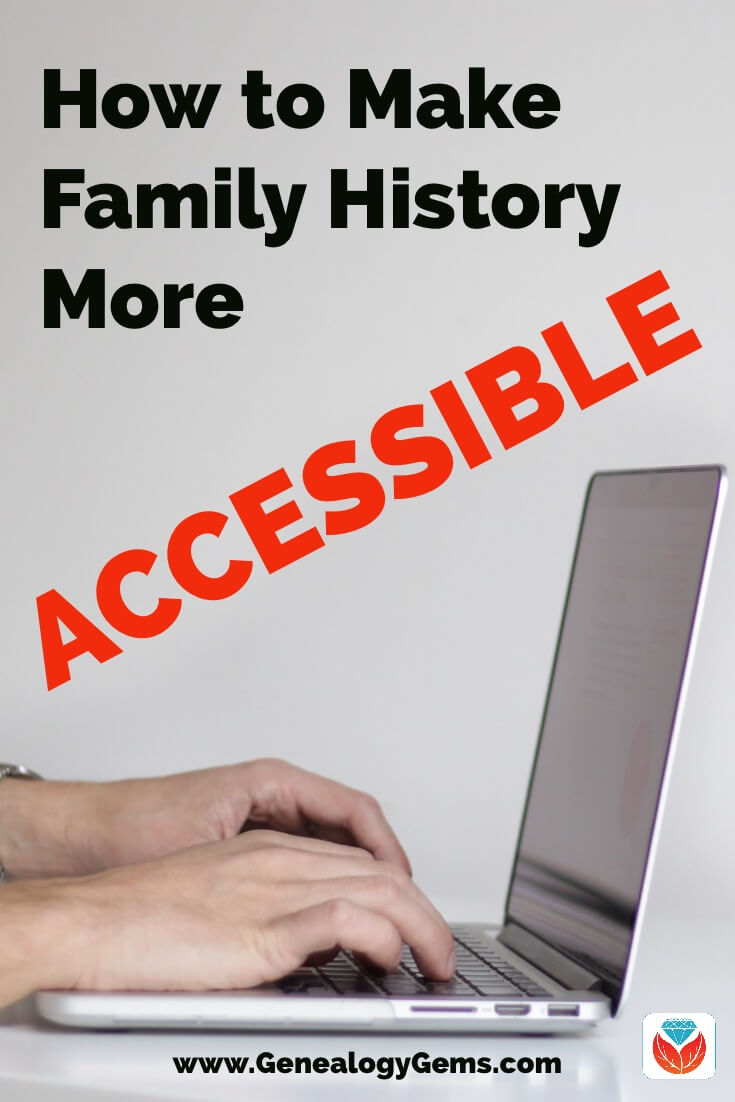Making your family history accessible to your visually or hearing impaired relatives may require a little extra work. But the effort can mean making your genealogy discoveries more available and vivid for EVERYONE–now and in the future. Let these ideas help you!
Making family history accessible
I’ve written and lectured extensively on making family history more interesting for the non-genealogists in our families, particularly the next generation. But kids and grandkids aren’t the only people we should be striving to reach.
Genealogy Gems Podcast listener Amanda recently wrote me about her situation. Her grandmother is interested in what she is discovering but has barriers to enjoying the information. Here’s what Amanda wrote:
“My grandmother is one of my only family members who is interested in my family history findings. She says that I have found information that she would have never known. Unfortunately, she is losing her vision, so showing her my findings is increasingly difficult. Do you have any ideas or resources that would help me present information in an organized manner that makes the information easier to read or makes use of her other senses? She wants to be able to read it, but I want to be flexible for her.”
How fortunate your grandmother is to have a granddaughter like you who cares enough to change up how you’re presenting the family’s story. Since she’s losing her vision, you can focus on other senses such as hearing. And since she would still really like to be able to read it, I’ve got some ideas for accommodating that as well. Let’s start by making text more readable.
Here are 3 ideas for sharing family history text with accessibility in mind:
MAKING FAMILY HISTORY ACCESSIBLE FOR THE VISUALLY IMPAIRED
- Consider printing a short book in large type. I’ve used both Lulu.com and Shutterfly to create books. Take a look at the editing tools and try dramatically increasing the font size. (I go into much more detail on how to create a family history book with on-demand services likes these in Genealogy Gems Podcast episode 206.) Choosing a template and sticking with it will help you end up with a consistent set of volumes over time that are easy to read and enjoy as an on-going family story.
- Create a free blog and set the type to a larger size. Some of the most popular free blogging services are Tumblr and Blogger.com. Here’s an article that discusses accessibility in web design and shows great examples with Tumblr. It’s interesting to note that accessibility isn’t just about being able to see the text. Color-blindness can also create barriers to using websites and blogs.
- Take a moment to show relatives with reduced vision how to increase the text size on all websites. It’s easy to do! Simply press the Control key and the Plus sign (Ctrl +) on your keyboard to enlarge the text on any web page, as shown here. In Google Chrome, once you hit Ctrl + one time, this little box pops up in the top right corner of the screen. If she can’t see well enough to use it to further enlarge on-screen material, she can keep hitting Ctrl +. That’s what I did to enlarge the screen here to make one of my family history blog posts easier to read. You can instantly return the font size to normal by using the Control key and the number zero. Or incrementally reduce it with Control and the minus sign.
- To make your blog more user-friendly for the blind, follow these tips from the American Association for the Blind.
- Adding tags to digital images makes them richer for everyone. Visually-impaired relatives particularly benefit because they can use their favorite voice-to-text tool or screen reader to read them. Here are some instructions for adding tags to digital images you upload to FamilySearch.org.
Accessible audio for the vision-impaired
If your visually-impaired relative has a smartphone or tablet and is comfortable using it, consider using a Cloud-based note-taking app such as Evernote or One Note to record “audio” notes that can be shared through the service. You can record yourself reading and commenting on your latest genealogical finds. Even if they don’t want to use Evernote, you can create your audio notes and then share them via private links, or even right-click on the audio file in the note and save it to your computer to be attached to a standard email.
If you want to really get into recording and editing your audio, I recommend the free audio editor Audacity (it requires a bit more tech know-how). You can save audio mp3 files to Dropbox or Google Drive for easy sharing.
Accessible video for vision impaired
It may not seem logical at first glance to create video for the vision impaired. But in fact, video as a medium is an easy way to deliver audio. If you have a free Google account you can upload your videos to YouTube, making them super-easy to access. In fact, if you visit my Genealogy Gems YouTube channel, you’ll see that I publish all of my audio podcasts as video.
You can create very simple videos using your recorded audio and just a single image. You can easily create these types of videos using free tools that come with your computer, or with video creation apps on your mobile device. (See my book Mobile Genealogy for my favorites.)
Sign in to YouTube.com with your Google account, and then upload your video. You will find an Upload button at the top of every page on YouTube, or you can go to Creator Studio in your account. Creator Studio is where you can manage your own free YouTube channel, which is where your relatives will find all of your videos in one place. The channel gives you many controls, including making your videos “private” and only accessible from a direct link, which you can email to your relative. All they have to do is click the link in your email and they will be taken to your video where they can listen to your latest family history stories on video. You can also mark your video as “unlisted,” which will dramatically reduce the public traffic to it while still making it easily accessible to your relatives. You can learn more about uploading videos and creating your YouTube channel in my book The Genealogists’ Google Toolbox.
YouTube for the Hearing Impaired: Once you are signed into YouTube with your free Google account, you will have the Creator Studio available to you. This is where you upload your videos. It also features a wealth of production tools including the ability to add subtitles and closed captioning. You have 3 ways to add the captions:
1. Upload a text transcript.
2. Transcribe in Creator Studio and auto-sync it to the video. Type or paste in a full transcript of the video and subtitle timings will be set automatically.
3. Create new subtitles or CC (Closed Captioning) by typing them in as you watch the video.
Start by creating a video that includes the family history information you want to share (photos, documents, old home movies along with narration, etc.). The newest and easiest way to create videos like this (which are more complex than the single image video mentioned for the vision-impaired) is to use a drag-and-drop video creation tool like Animoto (use the free version or purchase an affordable subscription to get HD-quality downloads without watermarks). You can easily and quickly create videos on either your computer or mobile device using the Animoto app for iOS or Android. Animoto offers a narration tool, or you can upload your own mp3 audio file to the project. Download the HD quality video to your computer for archiving, and then upload a copy of it to YouTube. Add closed captioning.
Sharing family history with all audiences
Let Genealogy Gems be your guide when it comes to sharing your family history via blog, book or video. Our website is packed with ideas to inspire just the right approach for sharing your genealogy discoveries, stories and photos with your relatives! Click here to explore family history writing ideas on the blog. Or watch this quick video for other sharing ideas. It’s a free preview of my full-length video class, Inspiring Ways to Capture the Interest of the Non-Genealogists in Your Family, available as part of your Genealogy Gems Premium eLearning membership.

About the Author: Lisa Louise Cooke
Lisa is the Producer and Host of the Genealogy Gems Podcast, an online genealogy audio show and app. She is the author of the books The Genealogist’s Google Toolbox, Mobile Genealogy, How to Find Your Family History in Newspapers, and the Google Earth for Genealogy video series, an international keynote speaker, and producer of the Family Tree Magazine Podcast.







Lisa, thank you SO MUCH for providing this information. With a few small changes and a little bit of forethought we can make our beloved research and documents accessible to more of our family and friends. I remain grateful for all you do.
Thank you Suzanne for your kind comments!